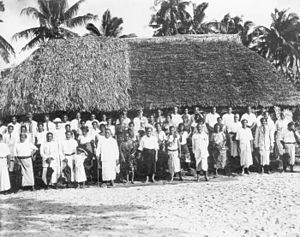

Falefa | |
|---|---|
| Le Aai o Fonoti. Le Aai o le Tupu | |
 | |
| Country | Samoa |
| District | Atua |
| Founded | 300 B.C. |
| Government | |
| • Type | Council of Chiefs |
| Population | |
• Total | 1,563 (2,016 census) |
Falefā is located on the north eastern coast of Upolu island in Samoa.[1] It was the ancient capital during the ‘Malo’ (‘government’) of Tupu Tafa'ifa (King) Fonoti. After having defeated his nephew Toleafoa and sister Samalaulu for control of Samoa (his brother Va'afusuaga refused to take part in the war and remained in Savaii) King Fonoti chose to rule from his new seat in Falefa, an honour remembered in its faalupega (Charter and Salutations) to this day.[2]
Falefa is headed by the descendants of its two founders - Moe’ono Falealoga (tulafale-alii or 'matua') and Leutele Leutogatui (matuaalii), the sons of Tui Atua Lemua'iteleloloa and his wife, Leateafaiga.
It is situated in the Anoama'a 1 electoral constituency which itself is situated within the larger ancient political 'district' of Anoama’a, a province of Atua. Atua is headed by the Tui Atua (sovereign of Atua), a title once held by the seer Tui Ātua Leutele (called Tui Atua Leutelelei'ite) in the 10th century, during Samoa's period of antiquity.[3] Since the 17th century, this mantle has been occupied mainly by one of the two Tama-a-'āiga (maximal lineage chiefs) of Ātua's Salamasina line: Tupua Tamasese and Matā'afa.
Together with the village of Salani, Falefa is home to one of Samoa's main political families, 'Aiga Sā Fenunuivao (descendants of Fenunuivao, wife of King Muagututi'a and mother of the first Tupua, Fuiavailili). The family is led by Moe'ono and Leutele of Falefa and Tofua'iofo'ia and Fuimaono of Salani, and is the custodian of the Tama-a-'Āiga Tupua Tamasese title.[4] Both the Tama-a-'āiga Tupua Tamasese and pāpā Tui Atua royal titles are currently held by Samoa's former Prime Minister and Head of State, His Highness Tui Atua Tupua Tamasese Efi.[4]
- ^ "Samoa Territorial Constituencies Act 1963". Pacific Islands Legal Information Institute. Archived from the original on 5 June 2011. Retrieved 18 December 2009.
- ^ Le Mamea, MK (1930). O le Tusi Faalupega o Samoa: Savaii, Upolu, Manono ma Apolima. Malua, Samoa: Fale Lomitusi a le LMS. p. 84.
- ^ Cite error: The named reference
:2was invoked but never defined (see the help page). - ^ a b Tuimaleali'ifano, Morgan A. (19XX). (2006). O tama a 'aiga he politics of succession to Samoa's paramount titles. Institute of Pacific Studies, University of the South Pacific. ISBN 978-982-02-0377-8. OCLC 494614506.
{{cite book}}: CS1 maint: numeric names: authors list (link)